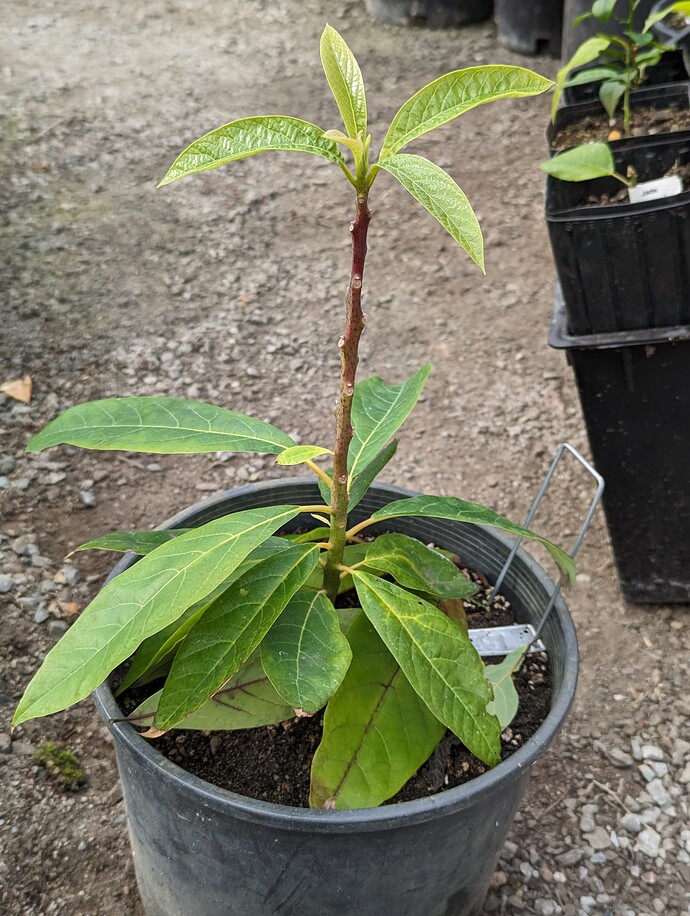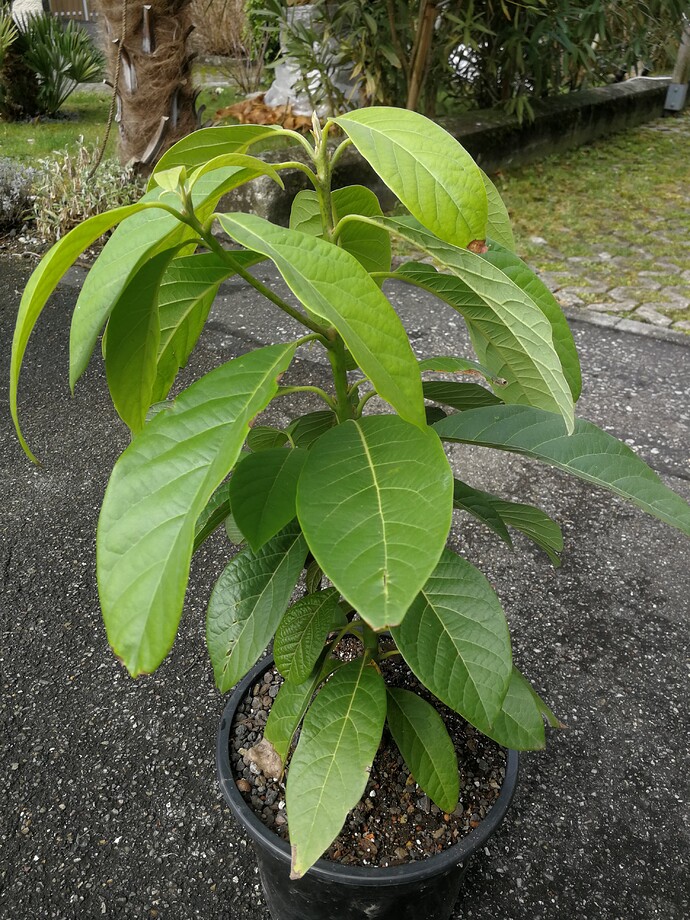In your photo, it looks like the seed coat is still intact for both of the seeds, at least on the top side, but if they were already cracking open on the bottom side, then I would just wait rather than pulling them up to peel them off. Usually the taproot emerges first, and the top shoot waits another few weeks to a month after that.
Thank you for the input Winn, I appreciate your experience.
There is a huge difference between this year and last year in terms of avocado flowering. Duke, which was by far the first to flower out of the trees that flowered last year, is barely budding out now:
Last year, it started like a month earlier and looked like this by around this time in February:
Duke still seems to be furthest along, though, at least out of the trees that flowered last year. Joey is at about the same stage, but looks like only vegetative buds, same as last year:
Aravaipa is nearly at that stage as well, though it had only one small flower cluster last year and once again looks like mostly vegetative buds:
Linh (on the same multi-graft tree) is still basically entirely dormant:
The furthest along of anything in the greenhouse is the unknown variety “Rincon Valley” collected by @jsteph00921 from a tree growing in a public parking lot in that valley:
That is grafted on a potted Zutano seedling, and surely isn’t big enough to fruit, but I’ll let it flower so I can collect pollen anyhow:
One other interesting thing from the project, this Duke seedling has recently aborted a bunch of otherwise healthy looking leaves that were the most tender leaves when it experienced freezing temperatures more than a month ago:
The part of the stem that was tender during that freeze also turned a pink/purple color that the older and younger stems don’t have as much of:
I’ve never seen any avocados that seemed inclined toward being deciduous, but this is the closest I’ve seen yet.
Winn:
What type of predator control is black card in pic #2?
Chris
They were green lacewing eggs, which I got to combat aphids. Any cards that the slugs didn’t find (and scour clean) hatched into larvae that were promptly eaten by spiders. I later released ladybugs in the greenhouse, and they cleaned up the aphids, but were also mostly eaten by spiders.
No aphids this winter, though! One of the trees has a bad case of soft scale that I’ve had to attack with cotton rags and soap, I wish I knew of a good predator to release that would eat scale! I’ve seen a few slugs going after it, but never any other predators.
Yeah, I tried green lacewing eggs in ghouse for scale but ants devoured them all. They must be a prime item on the menu!
https://growingfruit.org/t/green-lacewing-trial-for-ghouse-not-so-good/
There’s also this predator for scale- but too expensive: Red Scale Parasite (Aphytis melinus)
@Bradybb 's suggestion to use diatomaceous earth to control ants really worked. After a DE dusting, I’m ready to try green lacewings again.
Several ladybug releases throughout the spring/summer/fall have worked for me to keep down the ghouse aphid population …but I only found one lone ladybug yesterday on citrus after the release of hundreds (thousands?) throughout the year!
I’m lucky I’ve never seen ants in the greenhouse, they will definitely defend their farm animals (aphids, etc.) from any and all predators. I’m guessing the healthy population of spiders helps on that front, or maybe I’ve just been lucky so far and ants will be my next greenhouse battle!
Nearly two weeks later and still very little progress on the avocados. Here’s Duke now (different bud than the quoted post, but Duke’s buds are all around this stage now):
Duke forms callus much more aggressively than other cultivars, I wonder if this could be related to cold-hardiness? I’m imagining that the tree can heal some types of frost damage more quickly because of its callus formation. Here’s a spot where I removed scionwood in early winter:
Hi
I hope you dont mind me posting some picture here.
I live in Switzerland were, if you belive it or not, you can find hardy acocados along the lake shores in our southern canton ticino.
From there I got seeds which I mostly used for rootstocks. There is one mexican seedling that looks very different from all the other anis flavered varieties I know. The leaves are thick, leatherly and come along in very short distance to each other. Which I belive is gonna make a very dwarfish and bushy tree. Becouse of these features Im not going to use this one for rootstock.
Any Ideas what variety that could be?
Has anyone ever seen something like that?
Btw, the tree is going in its third year.
Marcel
I just received budwood of an avocado tree found growing in that region of Switzerland, so I believe it! Thank you for sharing your photos here.
Because it’s a seedling, it isn’t really any variety (avocado seedlings tend to be fairly genetically diverse). If the parent tree was also seed-grown, then it’s already at least two generations removed from any named cultivar, and it’s going to be impossible to figure out the lineage by phenotype.
Those nodes do look somewhat dense, but not quite as tight as “Duke” seedlings often are, and your leaves look less pointy and pale than Duke seedlings usually are, so I doubt it’s seedling of Duke, though it could perhaps be descended from Duke or Duke7 (which was itself a seedling of Duke). Here’s an example of a Duke seedling:
Here’s another Duke seedling, this one is even more tight node spacing:
But honestly, it could be almost anything. I’ve had seedlings of Mexicola Grande that looked very similar to your tree, too, and I’ve seen tight node spacing on some seedlings of unnamed Mexican avocados. Its ancestry doesn’t matter too much. If it makes good fruit some day, you get to give it a new name!
Hi
Thank you for your coment. In fact the seedling on your second picture looks very similar to mine. It may have duke in it.
What do you think, how many years could it take to start blooming?
Very hard to know, avocados can sometimes flower in 3-4 years from seed, but also sometimes 20+ years. I’d say pot it up to a much bigger pot or plant it in the ground this spring. It may grow a lot faster once it’s in the ground.
Somehow the shape of the leaves of my seedling look like poncho leaves, but larger ond thicker.
I ordered scion wood from fruitwoodnursery.com last winter of the hardiest varieties for grafting.
All of them have more or less the same shiny typ of leaves, only the poncho is a bit different. But this seedling looks different, like it’s going to be a tough plant with dick textured leaves which gives it a whole different look.
That has not been my experience, cold-hardy avocados have a wide range of different leaf sizes, shapes, textures, and colors.
Some (Del Rio, Jade, Joey) have very fuzzy new leaves, some are more shiny (Aravaipa, Ganter, Teague), some are in between (Duke, Poncho, Stewart).
Del Rio is very pink in the new leaves, Duke has pale lime green new leaves, Jade and Aravaipa are more of a deep green. Duke does have a pink color in the new stems, though, but not the leaves.
Jade and Mexicola Grande both have very large leaves, Duke usually has much smaller, narrow leaves (though its immature seedlings sometimes have bigger leaves).
Aravaipa, Ganter, Joey, and Stewart all have fairly prominent leaf veins on their mature leaves (indentations for the veins), while Duke, Jade, and Teague have smoother mature leaves.
In terms of seedlings that look similar to your seedling, Mexicola Grande seedlings often look similar, too. Here’s one of mine from the fall before it got winter damage:
I’ll repeat that I doubt you’ll be able to figure out much about it’s lineage from phenotype. Even the fruit will likely look very different from the parent or grandparent trees, assuming one of those was even a named cultivar.
Yes that one has some similarity to my seedling too. What ever it is Im excited about it and how it will turn out.
There in ticino where I colected the seeds are many different varieties growing close together. Mainly pure mexican plus some hybrids such as bacon.
EDIT: The person who’s grove was referenced here has asked that I take down the photos of his grove, so I’m doing so.
Original post:
I am in touch with someone who knows the person who maintains that grove. I think “Opal” is one of the Mexican types there, and I’ve never grown Opal before so I’m not sure what the leaves look like usually.
Yes, thats the place! Amazing how you found that one. I know him too, but unfortunatelly we got in a conflict with each other and he doesn’t wanna talk to me anymore.
Bill Schneider himself was there many years ago and thats how those mexican avocados came here, since there is no nursery selling them in europe until lately.
There are many different varieties for sure. Such as lila, poncho, wilma, topatopa, bacon and some others.
One of the new varieties I grafted this year was sent by the owner of that grove to our mutual contact, they call it “Brissago” and it was supposedly found growing on the grounds of a senior center somewhere nearby. I don’t know if those grafts have succeeded yet.















